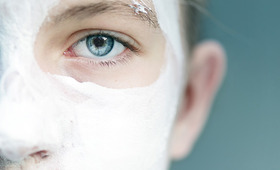
A few months after I turned 26, my pores turned against me. Tiny, flesh-colored bumps took up residence along my jawline and quickly spread to my cheeks and forehead. Looking back, I’m pretty sure it was karmic retribution for my relatively pimple-free teenage years. I was 100% convinced that my skin was stabbing me in the back.
After a bit (okay, many hours) of internet sleuthing, I diagnosed myself with a swift and inexplicable outbreak of closed comedones, which is fancy dermatologist speak for clogged pores underneath the surface of your skin. In the war against my suddenly bumpy skin, I employed a scorched-earth battle strategy: I double-cleansed twice a day, slathered myself in chemical exfoliants, and diligently applied weekly clay masks. I changed my pillowcase every night, stopped wearing makeup, and hit up my dermatologist for every acne medication I could get her to prescribe.
Nothing seemed to work. The closed comedones didn’t care about my stress levels, menstrual cycle, or elaborate skincare routine. Instead, they began to purge, slowly turning into a mountain range of red, inflamed pustules. At this point, I was so desperate, I probably would’ve bathed in the blood of a sacrificial lamb if I thought it would bring my skin back to its smooth, bump-free status.
I had resigned myself to living out the rest of my days as the poster child for adult acne when, for reasons completely unrelated to my skin, I started the keto diet. If you’re unfamiliar, the keto (short for “ketogenic”) diet involves eating very few carbs and a lot of fat. This puts your body into ketosis, which is a metabolic state where you burn fat for energy. Like many trendy ways of eating, keto is a bit controversial. Proponents claim it’s a miracle cure for weight loss, diabetes, PCOS and even Alzeheimer’s disease while detractors say it’s a fad diet whose safety hasn’t been properly studied and proven. One thing’s for sure: it’s not easy. You have to give up all things delicious and carb-rich like fruit, starches and grains.
It goes without saying that if you’re going to try a new diet, you should work with your healthcare provider to make sure you do it safely. In my case, within a few weeks of starting keto, those pesky closed comedones stopped popping up entirely. Slowly but surely, my skin smoothed out, save for a few lingering bumps that only went away after my facialist went after them with a comedone extractor (leave that to a professional, folks). I kept up with keto for about a year, mostly because I was worried that if I stopped, the bumps would come back with a vengeance. When I did start cautiously incorporating more carbs back into my diet, however, the bumps proved to be gone for good.
The research linking diet and acne is still pretty thin. There are many foods that are thrown around in conversations about acne (namely dairy and processed sugar), but science hasn’t drawn any solid conclusions yet. What I can say is that the keto diet seemed to help my skin. And while eating ultra-low carb isn’t something I can see myself committing to forever, I’m happy to have it in my back pocket—just in case my skin decides to rebel again.
You Might Also Like
-

Skincare
The Right Order to Apply Your Skin Care
- 784
-

Skincare
Spring Storage Solutions Part 2: Skin Care & Fragrance
- 170
-

Hair
Beauty Myth: Does Your Hair Grow Faster In The Summer?
- 270
-

Masks
Slumber Party D.I.Y. Beauty Ideas!
- 522
-

Brown Girl Beauty
Brown and Fabulous
- 77
-

Masks
Which Face Mask is Right For You?
- 3038







